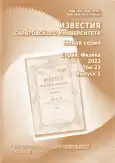Small-angle polarimetry as a technique for identification of nucleotide sequences in bioinformatics
- Authors: Zimnyakov D.A.1, Alonova M.V.1, Skripal A.V.2, Dobdin S.Y.2, Feodorova V.A.2
-
Affiliations:
- Saratov State Technical University named after Yuri Gagarin
- Saratov State University
- Issue: Vol 23, No 1 (2023)
- Pages: 46-55
- Section: Articles
- URL: https://journals.rcsi.science/1817-3020/article/view/250726
- DOI: https://doi.org/10.18500/1817-3020-2023-23-1-46-55
- EDN: https://elibrary.ru/IQKRQK
- ID: 250726
Cite item
Full Text
Abstract
About the authors
Dmitry Aleksandrovich Zimnyakov
Saratov State Technical University named after Yuri Gagarin77, Politechnicheskaya str., Saratov, 410054, Russia
Marina Vasil'evna Alonova
Saratov State Technical University named after Yuri Gagarin77, Politechnicheskaya str., Saratov, 410054, Russia
Anatoly Vladimirovich Skripal
Saratov State University410012, Russia, Saratov, Astrakhanskaya street, 83
Sergey Yur'evich Dobdin
Saratov State University410012, Russia, Saratov, Astrakhanskaya street, 83
Valentina Anatol'evna Feodorova
Saratov State University410012, Russia, Saratov, Astrakhanskaya street, 83
References
- Andelfinger G., Hitte C., Etter L., Guyon R., Bourque G., Tesler G., Pevzner P., Kirkness E., Galibert F., Benson D. W. Detailed four-way comparative mapping and gene order analysis of the canine ctvm locus reveals evolutionary chromosome rearrangements // Genomics. 2004. Vol. 83. P. 1053–1062. https://doi.org/10.1016/j.ygeno.2003.12.009
- Anisimova M., Bielawski J. P., Yang Z. Accuracy and power of Bayes prediction of amino acid sites under positive selection // Mol. Biol. Evol. 2002. Vol. 19. P. 950–958. https://doi.org/10.1093/oxfordjournals.molbev.a004152
- Rivas E., Eddy S. R. Noncoding RNA gene detection using comparative sequence analysis // BMC Bioinform. 2001. Vol. 2. P. 1–19. https://doi.org/10.1186/1471-2105-2-8
- Hwang D. G., Green P. Bayesian Markov chain Monte Carlo sequence analysis reveals varying neutral substitution patterns in mammalian evolution // Proc. Natl. Acad. Sci. U.S.A. 2004. Vol. 101. P. 13994–14001. https://doi.org/10.1073/pnas.0404142101
- Eddy S. R. A model of the statistical power of comparative genome sequence analysis // PLoS Biol. 2005. Vol. 3. P. e10. https://doi.org/10.1371/journal.pbio.0030010
- Gitter A., Siegfried Z., Klutstein M., Fornés O., Oliva B., Simon I., Bar-Joseph Z. Backup in gene regulatory networks explains differences between binding and knockout results // Mol. Syst. Biol. 2009. Vol. 5. P. 276. https://doi.org/10.1038/msb.2009.33
- Cooper G. M., Brudno M., Green E. D., Batzoglou S., Sidow A. Quantitative estimates of sequence divergence for comparative analyses of mammalian genomes // Genome Res. 2003. Vol. 13. P. 813–820. https://doi.org/10.1101/gr.1064503
- Abnizova I., Walter K. Te Boekhorst R., Elgar G., Gilks W. R. Statistical information characterization of conserved non-coding elements in vertebrates // J. Bioinform. Comput. Biol. 2007. Vol. 5. P. 533–547. https://doi.org/10.1142/S0219720007002898
- Orlov Y. L. Te Boekhorst R., Abnizova I. I. Statistical measures of the structure of genomic sequences: Entropy, complexity, and position information // J. Bioinform. Comput. Biol. 2006. Vol. 4. P. 523–536. https://doi.org/10.1142/S0219720006001801
- Sorek R., Safer H. M. A novel algorithm for computational identification of contaminated EST libraries // Nucleic Acids Res. 2003. Vol. 31, iss. 3. P. 1067–1074. https://doi.org/10.1093/nar/gkg170
- Altschul S. F., Gish W., Miller W., Myers E. W., Lipman D. J. Basic local alignment search tool // J. Mol. Biol. 1990. Vol. 215. P. 403–410. https://doi.org/10.1016/S0022-2836(05)80360-2
- Guide to Human Genome Computing / ed. M. J. Bishop. 2nd ed. San Diego, CA, USA : Academic Press, 1998. 306 p.
- Automated DNA Sequencing and Analysis / eds. M. D. Adams, C. Fields, J. C. Venter. 1st ed. San Diego, CA, USA : Academic Press, 1994. 368 p.
- Bioinformatics for DNA Sequence Analysis / ed. D. Posada. 1st ed. Totova, NJ, USA : Humana Press Inc., 2009. 368 p. https://doi.org/10.1007/978-1-59745-251-9
- Оптическая голография: в 2 т. / под ред. Г. Колфилда. М. : Мир, 1982. Т. 2. 186 с.
- Ulianova O. V., Zaytsev S. S., Saltykov Y. V., Lyapina A., Subbotina I., Filonova N., Ulyanov S. S., Feodorova V. A. Speckle-interferometry and speckle-correlometry of GB-speckles // Front. Biosci. (Landmark Ed). 2019. Vol. 24. P. 700–711. https://doi.org/10.2741/4744
- Ulyanov S. S., Ulianova O. V., Zaytsev S. S., Saltykov Y. V., Feodorova V. A. Statistics on genebased laser speckles with a small number of scatterers: Implications for the detection of polymorphism in the Chlamydia trachomatis omp1 gene // Las. Phys. Lett. 2018. Vol. 15, № 4. Article number 045601. https://doi.org/10.1088/1612-202X/aaa11c
- Goodman J. W. Introduction to Fourier Optics. 4th ed. New York, USA : Macmillan Learning, 2017. 564 p.
- Goodman J. W. Statistical Optics. 2nd ed. Hoboken, NJ, USA : J. Wiley and Sons, Inc., 2015. 544 p.
- Chipman R., Lam W.-S. T., Young G. Polarized Light and Optical Systems. 1st ed. Boca-Raton, FL, USA : CRC Press, 2018. 1036 p. (Optical Sciences and Applications of Light).
- GISAID: Official hCoV-19 Reference Sequence. URL: https://gisaid.org/wiv04/. Acc. ID: EPI_ISL_402124 (дата обращения: 15.08.2021).
- GISAID: Official hCoV-19 Reference Sequence. URL: https://gisaid.org/wiv04/. Acc. ID: EPI_ISL_2552101 (дата обращения: 15.08.2021).
- GISAID: Official hCoV-19 Reference Sequence. URL: https://gisaid.org/wiv04/. Acc. ID: EPI_ISL_9991311 (дата обращения: 15.08.2021).
- Bennett C. H., Brassard G. Quantum cryptography: Public key distribution and coin tossing // Proceedings of International Conference on Computers, Systems & Signal Processing, Dec. 9–12, 1984, Bangalore, India. IEEE, 1984. P. 175–179.
- Bennett C. H., Brassard G. Quantum cryptography: Public key distribution and coin tossing // Theoretical Computer Science. 2014. Vol. 560 (part 1). P. 7–11. https://doi.org/10.1016/j.tcs.2014.05.025
- Bennett C. H. Quantum cryptography using any two nonorthogonal states // Phys. Rev. Lett. 1992. Vol. 68. P. 3121–3124. https://doi.org/10.1103/PhysRevLett.68.3121
Supplementary files









